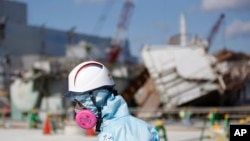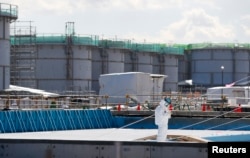Japan’s first criminal charges in connection with the meltdown of nuclear reactors in 2011 will be filed imminently, a lawyer in charge of the case told reporters Friday.
Indictments against three former executives of Tokyo Electric Power Co. (TEPCO) are expected Monday in Tokyo District Court. The trio is alleged to have failed to take measures to prevent the tsunami-triggered crisis at the Fukushima-1 nuclear power plant.
“The victims of TEPCO's man-made nuclear disaster have been demanding transparency, have been demanding disclosure and unfortunately they've been given neither by the utility. So this is a big step down the road of justice for the Fukushima victims,” said Kendra Ulrich, senior global energy campaigner for the Greenpeace environmental organization, reacting to the news of the impending indictments.
The three TEPCO executives, who will face charges of professional negligence resulting in death and injury, are Tsunehisa Katsumata, the utility's chairman in 2011, and two former vice presidents: Sakae Muto and Ichiro Takekuro.
Katsumata stepped down from his post in 2012.
After the accident, more than 14,000 Japanese citizens filed a lawsuit against TEPCO officials, accusing them of ignoring research and not taking the necessary steps to prevent the catastrophe.
Prosecutors decided not to indict the company executives in September 2013, but the decision was overturned in July 2015 by an independent citizens' judicial panel that mandated the trio be charged on the grounds of not foreseeing the risks of a major tsunami prior to the disaster.
“It has gone through two different committee panels which did not bring criminal charges and this third panel has decided to forcibly indict,” Ulrich told VOA from Tokyo. “So it's a major victory for the people that have been waiting for a very, very long time for some kind of justice and a process that can start to bring to light some of the things that TEPCO has refused to disclose so far.”
The world’s worst nuclear accident in a quarter of a century was triggered when a magnitude 9.0 earthquake on March 11, 2011 triggered a 15-meter tsunami that devastated Japan’s northeastern Pacific coast, swamping the Fukushima-1 nuclear plant.
The cleanup is expected to last decades and cost hundreds of billions of dollars.
TEPCO acknowledged Thursday it failed for two months to announce that meltdowns had occurred in the cores of three of the reactors, saying its officials were unaware of a company emergency manual defining a meltdown as damage exceeding five percent of a reactor’s fuel.
The boiling water reactors were based on an early 1960's design supplied by General Electric of the United States and two Japanese companies - Hitachi and Toshiba.
Ordered to evacuate - never to return
The tsunami slamming into the plant prompted an order for all those in a 20-kilometer radius from the plant in Fukushima prefecture to flee.
Tens of thousands of families left their homes. Some may never be permitted to reside in their houses again due to lingering, unacceptable levels of radioactivity in the soil.
The meltdowns also have had severe repercussions for the nuclear power industry in resource-poor Japan. Before the 2011 disaster, the heavily industrialized island nation was dependent on nuclear power for nearly one-third of its energy needs.
Kansai Electric Power Company (KEPCO) on Friday said it has restarted a reactor at its Takahama nuclear plant in Fukui prefecture, the fourth unit in Japan reactivated under stricter safety rules following the Fukushima disaster.
Thousands of workers are dedicated to keeping under control the crippled Fukushima plant’s six reactors, four of which either melted down or were severely damaged.
Despite objections of environmentalists, TEPCO has dumped hundreds of tons of groundwater from below the plant into the Pacific Ocean. It is a tiny portion of the 850 tons of groundwater pumped to the surface daily to undergo treatment before being placed in storage.
Nearly 700,000 tons of water used to cool the reactors during the meltdowns are also stored on site.
The U.N.'s International Atomic Energy Agency has called the decontamination effort commendable but driven by unrealistic targets.
Nine million cubic meters of radioactive waste, much of it soil, are stored unsheltered in black bags throughout Fukushima prefecture. The bags, scattered at 115,000 locations across Fukushima, are supposed to be moved to yet-to-be built interim facilities, encompassing 16 square kilometers, in two towns close to the crippled nuclear plant.
Authorities say the temporary storage sites are to hold the contaminated material for no more than 30 years before it is processed in a different prefecture.
More than 18,000 people are confirmed to have died or are still listed as missing from the 2011 quake and subsequent tsunami. There were no deaths due to radiation from the meltdown of the reactors, but more than 1,000 fatalities have subsequently been attributed to the mandatory evacuation.
VOA Correspondent Steve Herman reported on site in Fukushima as the nuclear disaster unfolded in 2011.











